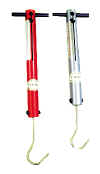Laura Bougault
2 complete "Not-a-knot" pack-saddles
4 fiber-glass panniers (Ralide Horsepack Panniers)
2 big top-packs
2 heavy duty saddle pads
We haven't been disappointed. To pack the horses is as easy as it sounds, and we have crashed in to trees and rocks, dropped the boxes, and basically tested the whole system quite roughly. Horses have run scared away in full gallop, fallen, climbed up and down, but not a single time have we had trouble with sliding cargo. Both the saddles and the pack-boxes have stood up to the test. The top-packs and the saddlebags are not as watertight as promised, but we are pleased with the functionality. We made a rain cover for the cargo, and we use a Uruguayan rain-poncho that covers us and the whole horse, so everything works OK.
The only negative part about the fiber-glass boxes are the weight, but we wouldn't change anyway. They are very useful, and we use them as chairs, tables, backrests and you can fill them with water for the horses or do the laundry in them.
All in all we are very satisfied with both what we bought from Outfitters Supply, and also with the service we have received. Our horses are not of the biggest, and when we contacted Russ Barnett and told that we thought that the pack-boxes were a little bit to low on our horses, he immediately sent us, free of charge, new attachment-straps for the boxes. That solved our worries.
Howard Saether and Janja Kovačič
To contact Outfitters Supply: Outfitterssupply.com



